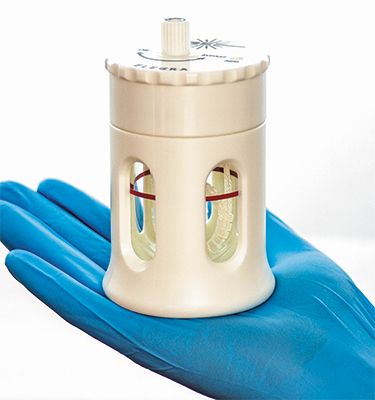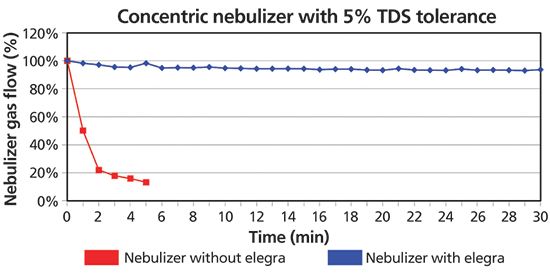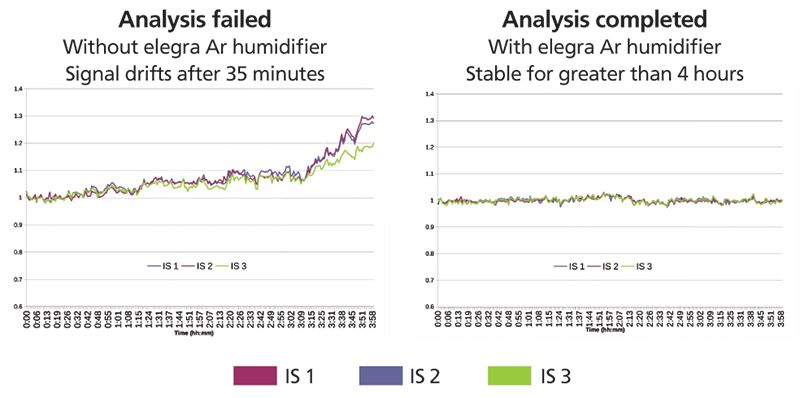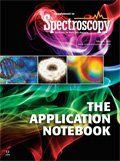The Elegra Humidifier: Uninterrupted and Maintenance-Free ICP Operation
Application Notebook
The elegant design of the Elegra results in a very compact accessory (Figure 1), making it easy to fit every ICP model without overcrowding the sample compartment. The Elegra utilizes highly efficient membrane technology to add moisture to the argon as it flows through the inert metal-free construction. The device runs at atmospheric pressure and does not require heating or electric power. The Elegra is also configured with a bypass switch so that the operator can turn humidification on and off without connecting or disconnecting any tubing. For easy installation on any ICP instrument and nebulizer, each Elegra Kit is packaged with customized gas connectors.
It is standard operation to use dry argon as your ICP nebulizer gas in order to generate an aerosol and transport the sample to the plasma. However, when dealing with samples containing high amounts of total dissolved solids (TDS), you have an increased likelihood of salt deposits forming at the tip of the nebulizer and injector. This can result in a failed analysis due to a drift in signal or worse, an extinguished plasma. In order to handle a challenging matrix, like high TDS, it's important to optimize your ICP sample introduction system. This includes choosing a nebulizer with the ability to handle high TDS, a baffled cyclonic spray chamber to minimize droplet size, and a large bore injector to allow for longer run times. For optimum performance you can also humidify the nebulizer gas before it comes in contact with the sample, decreasing the likelihood of salt deposits forming at the nebulizer and injector tips.
Glass Expansion designed the Elegra™ argon humidifier to provide an efficient, but simple to use humidifier for ICP-OES and ICP-MS applications. In this article we will focus on the advantages of the Elegra design and the benefits of adding a humidifier for high TDS applications.
Design
The elegant design of the Elegra results in a very compact accessory (Figure 1), making it easy to fit every ICP model without overcrowding the sample compartment. The Elegra utilizes highly efficient membrane technology to add moisture to the argon as it flows through the inert metal-free construction. The device runs at atmospheric pressure and does not require heating or electric power. The Elegra is also configured with a bypass switch so that the operator can turn humidification on and off without connecting or disconnecting any tubing. For easy installation on any ICP instrument and nebulizer, each Elegra Kit is packaged with customized gas connectors.

Figure 1: Elegra argon humidifier with bypass switch.
ICP-MS is being used more often, in place of ICP-OES and AA techniques, for trace metals analysis of high matrix samples like seawater and geological samples. For this reason, a dilution gas is now a standard option on most ICP-MS instruments (1–3). Inline "aerosol dilution" of the sample prior to introduction into the plasma greatly improves the plasma robustness, allowing for improved analysis of high matrix samples by ICP-MS. High matrix samples also need to be diluted for ICP-MS analysis in order to prevent the rapid build-up of salt deposits on the interface cones, which would otherwise result in signal drift. Relying on aerosol dilution rather than offline dilution of the samples (4) prevents errors associated with manual sample preparation. The Elegra Dual uniquely allows for humidification of both the nebulizer gas and dilution gas for these types of ICP-MS setups. This helps to prevent nebulizer and injector blockages, while the moisture added to the dilution gas further improves plasma robustness (3).
Experimental
To evaluate the performance of the Elegra, a nebulizer stress test was completed aspirating a 25% NaCl solution, while monitoring the nebulizer gas flow with and without the Elegra (Figure 2). The 25% NaCl solution was aspirated continuously, with no rinsing. Typically the Conikal™ nebulizer would not be recommended for use with a high TDS matrix, as it only has a tolerance of up to 5% TDS. However it was used here to highlight the advantage of the Elegra. As expected, without the Elegra, the nebulizer was completely clogged after only 5 min. In contrast, the same nebulizer with the Elegra, held a relatively constant gas flow throughout the entire test (over 30 min).

Figure 2: Nebulizer high TDS stress test (25% NaCl) with and without the Elegra Humidifier.
Even when a proper high TDS nebulizer is chosen, some matrices like lithium metaborate fusions can pose a challenge. The high amount of dissolved solids in such matrices often requires frequent maintenance. Extended analyses are often re-run due to signal drift from the build-up of salts. An easy way to eliminate the drift and frequent maintenance is to add the Elegra. The stability of three internal standard (IS) lines were compared with and without the Elegra (Figure 3) by an ICP contract laboratory running a lithium metaborate method. Without the Elegra the IS signal begins to drift after 35 min, eventually resulting in a failed analysis (> 10% drift). With the Elegra there is virtually no variation in IS signal over a period of 4 h. A significant reduction in the required nebulizer maintenance was also observed, going over two months without a cleaning as opposed to weekly cleaning without the Elegra.

Figure 3: Internal standard stability in a 0.5% lithium metaborate method.
With respect to the ICP torch injector tube, it is recommended that you use a larger bore (>2.0 mm i.d.) for high TDS applications. Increasing the auxiliary argon flow will lift the plasma higher off the injector, this helps to slow the build-up of salts at the injector tip. Utilizing extended rinses in between each sample is also recommended. However, adding the Elegra will provide the greatest decrease in the rate of salt build-up at the injector tip.
Conclusion
The new Elegra is a compact argon humidifier that helps to alleviate salt deposits in the nebulizer and torch injector, allowing uninterrupted and maintenance-free ICP operation. The highly efficient membrane technology does not require a pressurized water reservoir, heating, or electric power. An inert metal-free construction eliminates any possibility of contamination, providing a reliable humidifier for high purity ICP-MS applications. And with an easy-to-use bypass switch, you can take the Elegra off-line without disconnecting any argon lines. Lastly the unique Elegra dual channel model provides the ability to humidify both the nebulizer gas and a dilution gas simultaneously.
References
(1) Agilent Technologies Application Note# 5989-7737EN, "Performance Characteristics of the Agilent HMI Accessory for the 7500 Series ICP-MS."
(2) Agilent Technologies Application Note # 5991-4257EN, "Performance of Agilent 7900 ICP-MS with UHMI for high salt matrix analysis."
(3) Perkin Elmer Product Note # 012394-01, "All Matrix Solution System for the NexION ICP-MS."
(4) Agilent Technologies Application Note # 5989-8573EN, "Eliminate the Dilution Step from ICP-MS Sample Prep with the Agilent High Matrix Introduction System."

Glass Expansion Inc.
4 Barlows Landing Rd, Unit 2A, Pocasset, MA 02559
tel. (508) 563-1800, Fax (508) 563-1802
Website: www.geicp.com

LIBS Illuminates the Hidden Health Risks of Indoor Welding and Soldering
April 23rd 2025A new dual-spectroscopy approach reveals real-time pollution threats in indoor workspaces. Chinese researchers have pioneered the use of laser-induced breakdown spectroscopy (LIBS) and aerosol mass spectrometry to uncover and monitor harmful heavy metal and dust emissions from soldering and welding in real-time. These complementary tools offer a fast, accurate means to evaluate air quality threats in industrial and indoor environments—where people spend most of their time.
Atomic Perspectives: Highlights from Recent Columns
March 3rd 2025“Atomic Perspectives,” provides tutorials and updates on new analytical atomic spectroscopy techniques in a broad range of applications, including environmental analysis, food and beverage analysis, and space exploration, to name a few. Here, we present a compilation of some of the most popular columns.